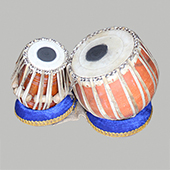Design Resource
Terracotta Dagga - Agartala, Tripura
Tabla Making
by
The process starts with the head of the Dagga, a fine goat’s hide is taken. The craftsman draws a circle by using a pencil on the goat’s hide in a required measurement. The hide is cut according to the drawn shape by using a chisel. It has to be cut in such a way that it should be even in all the angles. After that, the hide is soaked in water for a few minutes to make it soft. Then it is taken out from the water, and the outer layer is cleaned by using an iron metal tool. The circular pieces of goatskin are now graded as to quality. The lowest grade will have the centers removed and used to make the outer covering of the head. The medium grade is used for low cost, student grade tablas, while the highest grade is used for professional quality. The head is known as Chat. The Chat must now be made. The lower quality skins are utilized by folding them in half several times to form a triangle. The tip is cut off so that when it is unfolded, there will be a circle of about two to three inches in diameter that has been removed. A clay base is kept as a base of the lead part of the instrument. A strip of buffalo skin is rolled and kept under the bottom of the clay base. A string rope is used to tie the Chat and the base tightly. Even the stripped buffalo skin has been soaked inside the water for a few minutes. Once it is taken out a castor oil is applied to the strips, which will help sew the strips easily.
By using a pointed Chisel, holes are made on Chat one by one, and the striped skin is woven from the hole to the bottom rolled skin. Once the weaving around the Dagga is completed, the craftsman makes sure it is tight enough to hold it firm. The weaving begins by making vertical slits around the top edge of the Tabla. The Bayan requires 64 slits while the Dayan requires only 48. Care must be taken that all layers of the skin have been penetrated. Four long pieces of buffalo hide are used for the weaving. Each thong is first soaked in the water, and then lightly covered with castor oil. The four thongs are inserted into four adjacent holes up to their midpoints, thereby making four loose ends. There must be a central core around which the Gajara is woven. Taking four lengths of an inferior quality leather thong and wrapping them around the rim. The craftsman hammers the rim for stiffness. Syahi is the tuning paste applied to the head of the Dagga. Syahi is usually black in color; circular in shape. The black spot on the Indian drum is the most important component in determining its tonal color. This black spot, known as Syahi (Shahi, Gaab, or Ank) contains a commercially available black powder known as masala. The ink that is smeared on the top of the Tabla is usually a mixture of iron particles, gum, dough (of rice flour) and catechu, etc. It is smeared in the center of the skin and is called as GAB. It is a fine art to apply this GAB in the correct mixture, consistency, and strength of a paste. Once the mixture is applied, it is let to dry in the sun.
Finally, it is polished with a stone immediately after the excess paste has been removed, a polished piece of basalt is used to repeatedly rub the Syahi. A magnificent music instrument’s process is completed, and it is named as Tabla.















